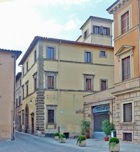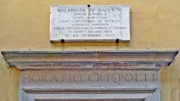

Palazzo Baglioni (16th century)

Pope Martin V conceded Bettona to the Baglioni family in 1425. When the citizens finally submitted to the Baglioni in 1439, a palace on this site became their family home in the town. In 1516, Pope Leo X gave Gianpaolo Baglioni the title of Count of Bettona in return for the quashing of a large papal debt that was owed to him. Bettona replaced Spello as the headquarters of a patrimony that also included Collemancio, Limigiano, Collazzone, Pomonte, Castelleone, Canalicchio, Deruta and Torgiano.
When Leo X executed Gianpaolo in 1520, his son Malatesta IV Baglioni took refuge here until his death in 1531. [Treachery to Florence] The white plaque above the entrance commemorates the fact that he died here.
The palace then passed in succession to
-
✴Rodolfo II Baglioni (died 1554);
-
✴Gianpaolo II Baglioni (died 1608); and
-
✴Malatesta V Baglioni, Bishop of Pesaro and Assisi (died 1648).
The palace then passed to the Conti Fiume and subsequently housed a barracks and a bank (Cassa di Risparmio). It is now the Hotel Palazzo Baglioni.

Palazzo Biancalana (1859-89)

The palace passed to the Commune after the death of Bianca Biancalana in 1920. It now houses the entrance to the Pinacoteca Civica and the Museo Civico.




